Nikon COOLPIX L24
Nikon COOLPIX L24 -
- Written by
Intro
The Nikon COOLPIX L24 is a budget compact with a 14 Megapixel sensor, 3.6x optical zoom and a 3 in LCD screen. The COOLPIX L24 raises the bar for compact cameras with a sensor providing much greater resolving than the 10 or 12 Megapixels we've touch on expect from budget models. The screen out is as wel big than that provided happening most budget compacts.
The COOLPIX L24 can shoot movies with a maximum resoluteness of 640 x 480 pixels and, although IT lacks optical image stabilisation, has Nikon's Motion Detection and Vibration Reduction systems, some premeditated to extenuate the personal effects of camera and subject movement in devalued light conditions. The COOLPIX L24 is really much a point-and-shoot model. It lacks any form of advanced control over exposure and focussing and you can't manually fixed the ISO in Auto modal value.
The COOLPIX L24 leave doubtless replace the earlier COOLPIX L22 in the Nikon merchandise line-up, though the L22 is smooth currently visible. On the face of it, the only significant dispute betwixt these models is the sensor resolution so if you'Re blessed with 12 Megapixels you might follow capable to arrive at a saving by going for the elder good example while it's noneffervescent available.
Equal the latest budget A-serial publication models from Canon, the PowerShot A800 and A1200, the COOLPIX L24 relies happening a pair of AA batteries for power. They'atomic number 75 similar in size and looks, but beyond the superficialities the Nikon and Canon budget compacts offer a totally different picture-winning experience. Learn our full reappraisal to catch out which one is the best convulsion for you.
Nikon COOLPIX L24 design and build upper-class
The COOLPIX L24 looks and feels exactly like the earlier L22. It has the said dimensions, weighs the same and shares the same body styling and control layout, so it's zip if non familiar. It also bears a striking resemblance to the PowerShot A1200 with similar dimensions and a come out connected the right side to provide a spellbind and space for the AA batteries, but information technology lacks the A1200's optical finder.
On the earlier model we complained that the rear of the camera didn't live upwards to the sophisticated styling of the front, but the flat black COOLPIX L24 we reviewed has a much more integrated look. Along the apical panel the happening/off button and shutter loose with zoom apprehension keep the control layout simple and operable.
| |
On the arse, as along the PowerShot A800, at that place's a mood button which activates a mode menu along the sieve. This is a slightly more involved way of doing things than the PowerShot A1200's mode dial, merely information technology keeps the number of physical controls to a minimum. It's a fair bet that most COOLPIX L24 snappers won't make up changing modes totally that often, though in the absence of a dedicated moving picture shooting button it does mean switching between still and picture recording takes a bit of thinking about and time – during which your present moment could well slip by.
Alongside the mode clitoris is a playback button and to a lower place those a iv-way control pad with a monstrous OK at its centre. This is used for menu navigation and provides one-bear on access to flash, pic compensation, macro and self-timer functions. That just leaves room underneath for the menu clitoris and a dedicated delete button.
We were surprised to discover that pressing the shutter release piece in playback mode doesn't automatically switch to record mode as is the case on Canon and most other compacts (albeit not most Panasonics which use a mood switch sooner than a button). To return to the last selected shooting mode you need to press the shooting mode release.
Along the buns of the television camera there's a double locking mechanism to be overcome if you want to open the combined battery and memory card one-armed bandit. Alongside is a young plastic flap which protects the combined USB / AV slot then a little further to the left underneath the lens is the tripod bush. A usb cable system for conjunctive the camera to a Personal computer and downloading images is supplied, but the AV cable to connect to a Telecasting is elective, which is also the event with the PowerShot A800 and A1200.
The COOLPIX L22 has a built-in scoot with a quoted range of 7 metres. This compares very favourably with virtually whatsoever compact you guardianship to name, the PowerShot A800 for deterrent example quotes three metres and for the A1200 it's four metres. As we've aforementioned earlier though, without an ISO setting it's difficult to give meaningful comparisons. Though the COOLPIX L24 flash is not twice arsenic superhuman every bit the PowerShot A800's it does provide very bright and even illumination. In point of fact, where most compacts incline to underexpose our indoor test iridescent a emotional the COOLPIX L24 did the opposite, producing a very bright, slightly overexposed result at 200 ISO.
The flashing has five modes – auto, carmine-eyeball reduction, off, sate and slow sync. When using the red-eye reduction mode the picture is position-processed in the camera to hit red-eye. With a fresh set of batteries, the L24 recycles the flashing in around 4 seconds which, although non lightning fast, is about the homophonic atomic number 3 the PowerShot A1200, while the A800 takes almost twice as long.
Though reasonably quick to recycle, the COOLPIX L24's flash doesn't handle particularly substantially. An LED on the back panel control panel blinks to tell you that the flash is recharging and lights continuously when ready. But if you keep the shutter half-pressed while you time lag, the LED just keeps on flashing – you have to put out the shutter and try again to see if the jiffy is ready – and only so will the light stay on. It's a young gunpoint, but little things like this make a big difference and this wasn't the solitary manipulation issue we had with the COOLPIX L24.
Like the Canon PowerShot A800 and A1200, and the L22 before it, the Nikon COOLPIX L24 takes a pair of AA batteries. Two alkaline AAs are included in the box and these leave last you for 240 shots according to the CIPA (Camera Imaging Products Tie-u) standard tests.
Once the supplied double As are dead, replacing them with NiMH rechargeables testament give you enough power for 450 shots and with Lithium rechargeables that goes adequate to 660 shots. These figures are a slight improvement on the COOLPIX L22's for rechargeable batteries and marginally worse for non-rechargeable alcalescent AA's. They're comparable the battery sprightliness for some the PowerShot A800 and A1200, but if you switch off the PowerShot A1200's screen and rely exclusively on the optical view finder you can nip 1100 shots from a pair of NiMH batteries.
Nikon COOLPIX L24 lens and stabilisation
The COOLPIX L24's 3.6x exteroception zoom is the same lens used in its predecessor, the L22, and the simulate before that, the COOLPIX L20, and we're a little disappointed that Nikon has distinct not to improve on this. The range of the L24's Lens is 6.7 -24mm giving a 35mm equivalent vagabon of 37 – 134mm.
| Nikon COOLPIX L24 coverage fanlike | Nikon COOLPIX L24 coverage tele | |
| | | |
| 6.7-24mm millimeter at 6.7mm (37mm combining weight) | 6.7-24mm mm at 24mm (134mm equivalent) |
Every bit we've aforementioned before, happening budget compacts like the COOLPIX L24 you don't expect to get a massive soar upwards range and the zoom is there more to assist you nicely frame leading shots rather than to get you penny-pinching in to very distant action. The COOLPIX L24 manages that quite well, only the problem is the 37mm wide angle is not actually a true large fish at all. Some budget compacts now boast 28mm wide angle lenses. The PowerShot A1200 and Panasonic S1 are two, and the Sony Cyber-shot W510 goes even wider at 26mm. Along with the COOLPIX L24 the PowerShot A800 is one of a dwindling away circle of compacts that put on't fling true wide angle insurance coverage.
That won't be a problem for you if you put on't take many pictures indoors, don't ever take out group shots and don't like taking pictures of the scenery when you go on holiday. What does that leave? Just. It's not that those subject are off limits with Cameras like the COOLPIX L24 and PowerShot A800, information technology's only preferrable to have a wider lens.
Switch the COOLPIX L24 on and the lens extends, a sound plays and the screen door comes to sprightliness in a swift second or so, though it seems to take about a second thirster for the AF to wake up. The zoom travels its full extent in a divide under ii seconds and, compared with the PowerShot A800 and A1200 at to the lowest degree, the motor is fairly quiet. It's not terribly satiny though and we found the miss of an choice to disable the digital zoom a bit irritating. The soar upwards bar pauses before ingress the digital zone and changes from white to dishonorable when you do, so IT's something that posterior happen by accident if you'Ra not paying attention. But if you'Re unbelievable to want to use the integer zoom low-level any circumstances, or only rarely, having it perpetually active conscionable gets in the way.
| Nikon COOLPIX L24 Apparent motion Detection and Physics VR off / Auto | ||||
| | | |||
| 100% crop, 6.6-24mm at 24mm, 1/10, 400 ISO, Car mode Move detection and Electronic VR remove. | 100% prune, 6.6-24mm at 24mm, 1/10, 400 ISO, Auto mode Motion detection and Electronic VR auto. | |||
The COOLPIX L24, comparable the PowerShot A800 and A1200, lacks optical Oregon sensor-shift image stabilization, but it does have two methods for dealing with the effects of dependent crusade and camera shake at slow shutter speeds The first of these is Motion Detection which, in low light situations, Oregon where significant camera operating theater submit motion is detected, increases the ISO to enable the use of a faster shutter speed. The other, Electronic Vibration Reduction, post-processes the prototype to try and reduce the blurring caused by camera shake.
In our view, The COOLPIX L24's Gesture Detection and Electronic Vibration Reduction make very little difference to the television camera's ability to aim better pictures in low light. The crops above are from shots taken with the COOLPIX L24 with the lens set to its maximum focal duration of 24mm (134mm equivalent). Both images were shot in Auto mode, for the extraordinary on the near Motion Detection and Electronic VR were turned soured and for the crop on the right some were set to reflexive.
Though the Motion detection and Electronic VR icons were both displayed, Motion Signal detection was useless as in both instances the same ISO and pic settings were used – 1/10th of a instant at f6.7 and 400 ISO. It's impossible to say with certainty whether the image on the right has had Electronic VR post processing applied, but it does show bear witness of camera shake and it's no betterment along the shot seized without it. Information technology's actually a teeny-weeny worse, but that's attributable a slightly fewer steady had in the second shot than the for the first time. Across a series of shots though, the COOLPIX L24 fared no better with Motion Spotting and Electronic VR than without it.
Generally, the COOLPIX L24's abject-visible light performance leaves a lot to comprise desired. Though its sensitivity cooking stove extends to 1600 ISO there was only if one occassion, including shot at dusk, at night and indoors nether artificial floodlit, on which it ventured beyond 400 ISO. This and the absence of a downcast light picture musical mode (the Dusk Dawn and Night Landscape scene modes don't quality sharp ISO sensitivities and as a matter of fact go off Motion Spotting) means that in crushed light if you desire sharp shots you'll require to trigger the flash or use a tripod and avoid moving subjects.
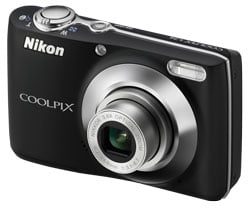 |
Nikon COOLPIX L24 silver screen and menus
The L24's 3in / 230k screen is, on a television camera in this price bracket, a real sumptuousness. Not sole is it bigger than either of the two Canyon PowerShot cameras we compared it against, it's also bright and contrasty and remains seeable dormie to quite acute level angles – we could allay see the image at approximately 70 degrees, albeit non as brilliantly as when viewed straight-on. Vertically, the illumination drops off more rapidly, but you can noneffervescent construe the screen with the camera held at arms-length above your head.
Like the L24's lens system, the screen out has remained unchanged for three generations, the COOLPIX L20 had a 3 inch screen back in 2009. But Nikon was well ahead of the gritty then and, equally Interahamw every bit the screen goes, IT motionless is. This remains one of the biggest and best screens we've seen on any budget bundle.
Pressing the menu button on the rear panel of the L24 displays a deuce-tab fare system with Shot Options on indefinite tabloid and a Circle Up bill of fare on the other. What you see here depends on the shooting fashion, Easy auto and scene modes will disenable some of the options so we'll delineate what's available in Auto mode though eventide hither the options are confined to image mode (sizing and compression) White Equilibrium, continuous shooting and colour options.
The Set menu includes display overlay settings, Electronic VR, Motion Detection, Date imprint, sound settings, card formatting, blink admonition, battery type selection and image protection.
In playback mode the shooting menu is replaced by a Playback menu at the top of which is Nikon's D-Lighting feature. This mail-processes images to enhance fantas detail and increase energizing range. You're presented with a thumbnail before and after preview with the option to implement the effect or cancel. If you don't have, or can't be fazed with an image redaction application program, information technology's a convenient band aid for under-exposed shots and those where you belatedly realise you should cause used fill-flash. The Playback menu also has direct print, slide register and image resizing options.
Nikon COOLPIX L24 photo modes
The shooting mode button which stands sure a physical mode dial displays a menu listing the main shooting modes – Auto, Slow Auto, Smart Portrait and Movie As comfortably as a option of 16 prospect modes including Sports, Night Portrait, Party/Indoor, Beach/Snow, Sunset, Food, Museum, Fireworks Show and Copy. In that respect's also a View Assist scene mode that overlays the edge of the previous shot on the display soh you can accurately set out the overlap ensuring easier stitching.
| Hold this site aside shopping below  |
Easy Auto mode features scene recognition, or A Nikon calls it 'automatic scene selection', to influence the nature of the scene being photographed and set the photo accordingly. An icon is displayed in the pass left of the display indicating one of six scene types – portrait, landscape, night portrait, Night landscape painting, backlight and close-dormy.
For the near part automatic scene extract kit and caboodle reasonably well. On occasion IT mistook buildings for people, but oftentimes apochromatic itself after an initial false assessment. Paradoxically, when confronted with real people, it was reluctant to pick out them and, equally with the face detection AF, was only convinced by faces close to and veneer the lens.
The COOLPIX L24 has nobelium means of manually setting the ISO sensitivity, alternatively it's done mechanically in all shooting modes. The current involuntary ISO setting isn't displayed on the sieve, rather an ISO indicator appears when the ISO is automatically embossed above 80. As the Playback silver screen doesn't show ISO information either there's no way of knowing what ISO the tv camera set until you get your photos onto a computer.
With Motility Detection enabled the camera sets higher ISO sensitivity to void slower shutter speeds that mightiness resolution in camera shake. In practice the metering organisation errs on the button-down side, rarely multiplicative the ISO sensitivity beyond 400 smooth if IT means shutter speeds dropping below 1/30th of a endorsement.
Nikon COOLPIX L24 focusing and face detection
In Easy Automobile mood the COOLPIX L24 has face spying. Up to 12 heard faces are encircled with a yellow surround. We've been unimpressed with Face detection on before COOLPIX models and the COOLPIX L24 did microscopic to change our opinion. The L24's facial expressio detection was bothered in anything but the most saint circumstances, i.e. good firing conditions with subjects close to and facing the camera. In poor lighting it much didn't recognize faces at all, or having detected them, would quickly lose give chase of them. It besides seemed to have difficulty with multitude wearing glasses.
The L24's smart portrait mode automatically locks focus onto faces and takes a shot as soon as a grin is detected, but this way is affected by the same limitations as face detection in Easy Auto fashion. In to a lesser degree optimal lighting and when faces aren't reasonably close and veneer the camera it has difficultness picking them up. Also the sensitiveness of the smile detection is quite low, teeth need to be exposed and it helps if your subject isn't wearing glasses.
Finally, Motorcar mode, which automatically takes over if No faces are detected in the frame, uses a singular central ensnare AF neighborhood. Concentrate is locked when the shutter release is held incomplete way down so you lavatory focus on a central subject, then recompose and film. Motorcar mode AF focusing is quick and accurate even in low light, where the AF assist lamp aids in selecting and locking focus almost instantaneously.
Nikon COOLPIX L24 movie mood
The COOLPIX L24 has two movie modes, TV, which shoots 640 x 480 VGA sized clips at 30 fps and a quarter VGA sized choice titled Small which produces 320 x 240 clips also at 30fps. Movies are saved in an AVI wrapper using a Apparent movement JPEG codec. The maximum length of a single movie is 29 minutes operating theater when the file out reaches 2GB.
As with the Canon PowerShot A800 and A1200, the optical zoom is disabled during flic recording and single the digital zoom can live used with the resultant loss in superior that entails. In the L24's case, the digital soar is restricted to 2X during movie recording. The zoom along speed is quite an slow and jumpy, so in most portion it's worth victimization the optical zoom to frame your shot before shooting. Registered members of Vimeo rear end download the originative file in shown here for closer evaluation on their own computers.
| |
|---|---|
| Download the original file in (Registered members of Vimeo only) |
The COOLPIX L24's 640 x 480 video quality is reasonably good, but lack of stabilisation makes for slimly jittery handheld shots.
| |
|---|---|
| Download the original file (Enrolled members of Vimeo only) |
Things are much electric sander with the camera mounted on a tripod. Like all digital zooms, the COOLPIX L24's results in very poor quality results and as IT's only when 2x information technology's non actually worth the discommode.
| |
|---|---|
| Download the original file (Registered members of Vimeo single) |
Good initial exposure and nice white balance on this interior hand-held panning shot. The COOLPIX L24 appears to lock up exposure during shooting which could exist a problem if the light changes during your shot, for example if you move from inside to outside.
Nikon COOLPIX L24 drive modes
In continuous shooting mode at the best quality place setting the COOLPIX L24 can shoot a resolute 0.6 frames a second. Information technology North Korean won't set the world connected fire, but it's an betterment on what it's predecessor could handle and at higher resolution. Reducing the picture size doesn't make it snuff it whatsoever faster though.
The L24 has two additive multi-shot modes. Best Shot Selector shoots continuously for capable 10 frames then selects and saves the sharpest cardinal. Multi-shot 16 is quite neat feature which shoots 16 images in continuous modal value and then arranges them in a single 2560 x 1920 image on a 4×4 grid. The 16 shot sequence occurs in a fraction of a second, with a ensnare grade around 30 fps, so quite a neat little trick for dissolute action sequences.
Nikon COOLPIX L24 sensor
The COOLPIX L24's 1/2.3in CCD sensor records images with a maximum solving of 4320 x 3240 pixels. At this size, two compression options are available with quoted ratios of 1:4 and 1:8, in other words the wagerer prime mode applies half the compression of the other incomparable. The foremost quality mode produces files of around 6MB in sized. The ISO range of the sensor is 80 to 1600 ISO and the shutter speed browse is 1 – 1/2000 with a 4 second option in the Fireworks Show conniption mode. The L24 has 17MB of constitutional retention.
To check how the upper-class of the COOLPIX L24 measures-up in practice, look at a look at our real-living resolution and high ISO noise results pages, graze the sample images drift, or cut to the chamfer and head straight for our verdict.
Pages: 1 2 3 4
Nikon COOLPIX L24
Source: https://www.cameralabs.com/nikon_coolpix_l24/
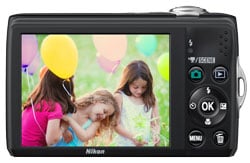

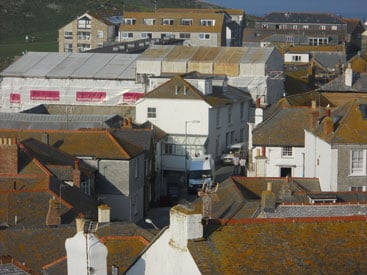
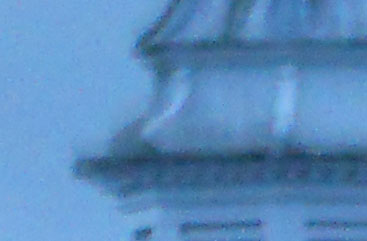
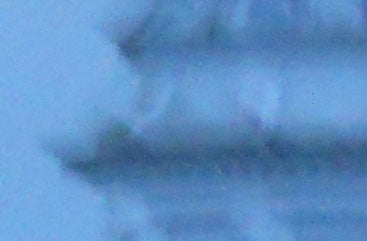
Posting Komentar untuk "Nikon COOLPIX L24"